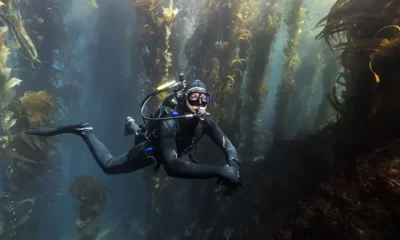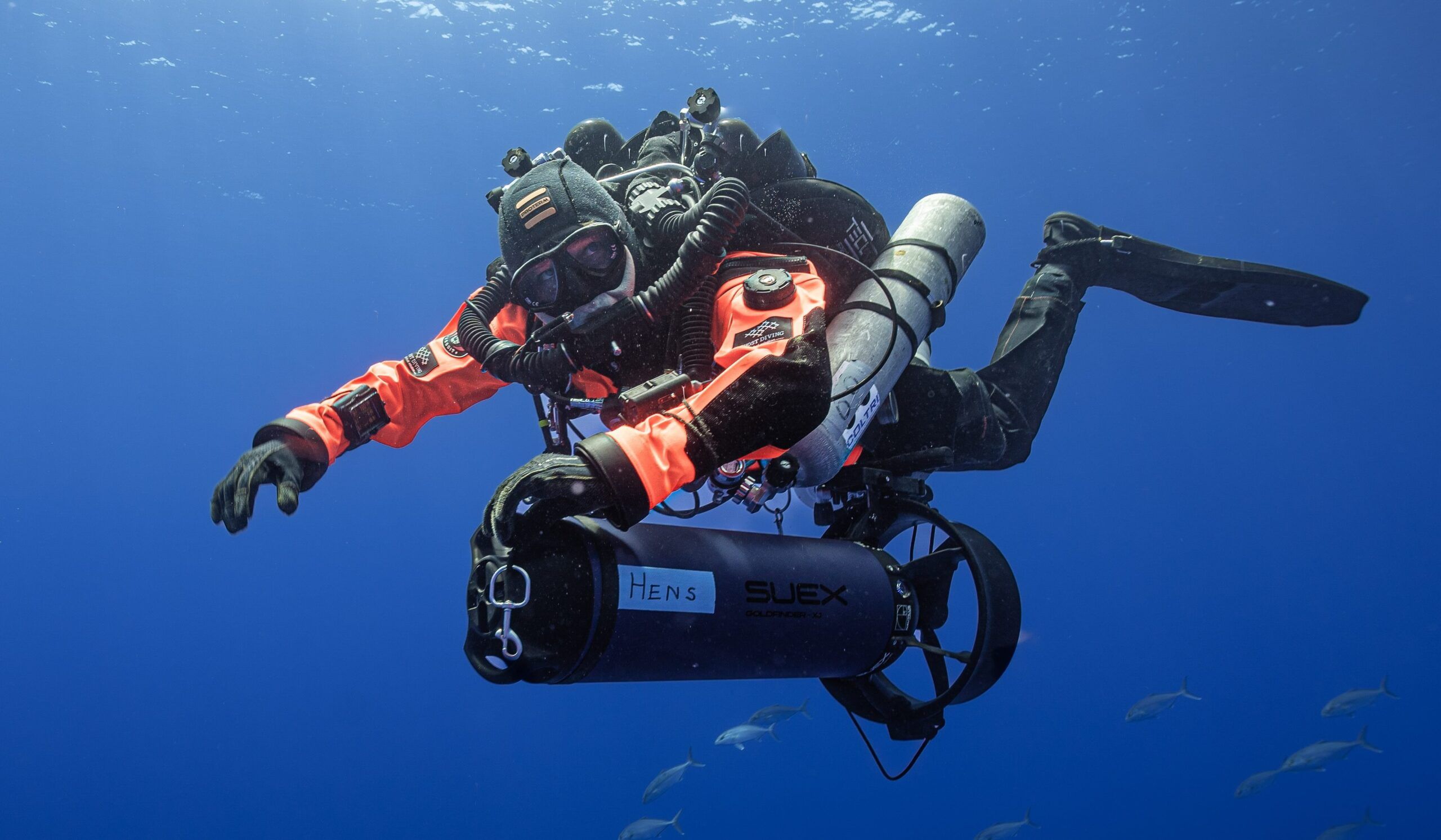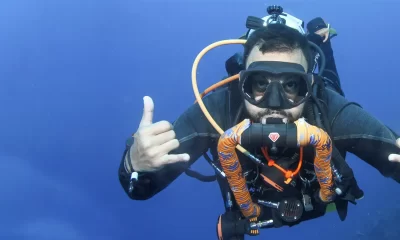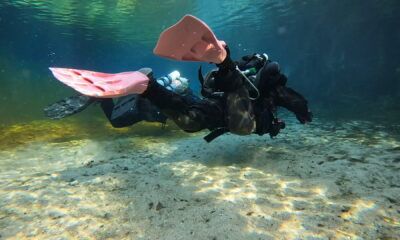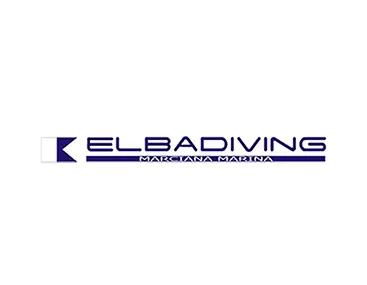Education
Too Much to Absorb: What You Need to Know About Your Scrubber
Reilly Fogarty dives into the history of CO2 absorption and illuminates the chemistry behind your rebreather’s scrubber, monitoring methods, scrubber duration, and how long you can store it between dives.
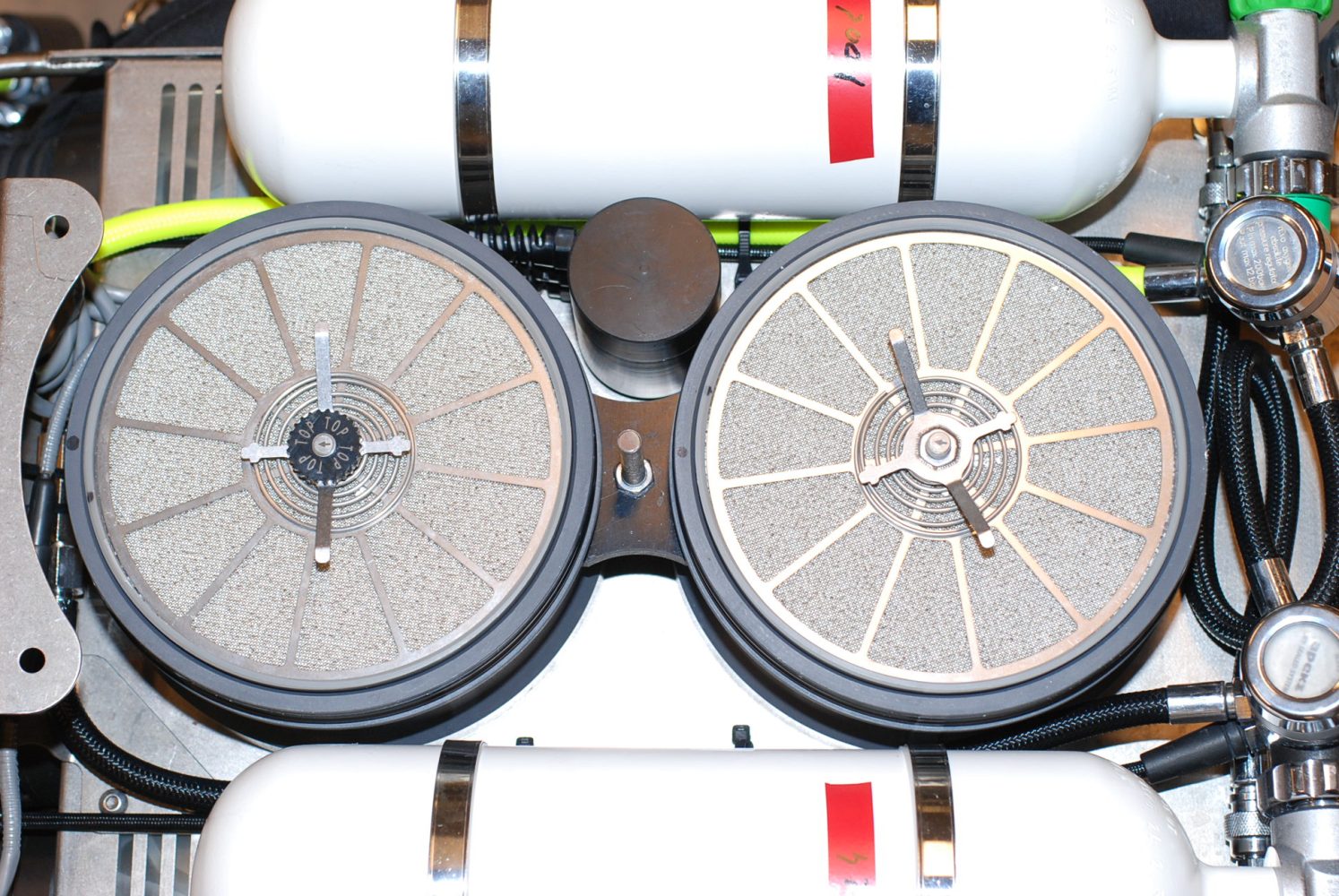
By Reilly Fogarty
Header photo: rEVO dual radial scrubber, courtesy of MARES
Add’l Resource: GUE’s ACE Method of Estimating Your Scrubber Duration
“Chemistry can be a good and bad thing. Chemistry is good when you make love with it (Ed.—or go diving!). Chemistry is bad when you make crack with it.” —Adam Sadler
Rebreathers are fickle things, and the dangers posed by their use are in no small part because of the carbon dioxide absorbent they use. Soda lime, also called “sorb” or referred to by the commercial names Sofnolime, Intersorb, or Sodasorb is a granular compound used to remove carbon dioxide from a closed breathing environment. It’s the latest iteration in carbon dioxide scrubbing solutions for diving equipment, and it’s here to stay for the foreseeable future.
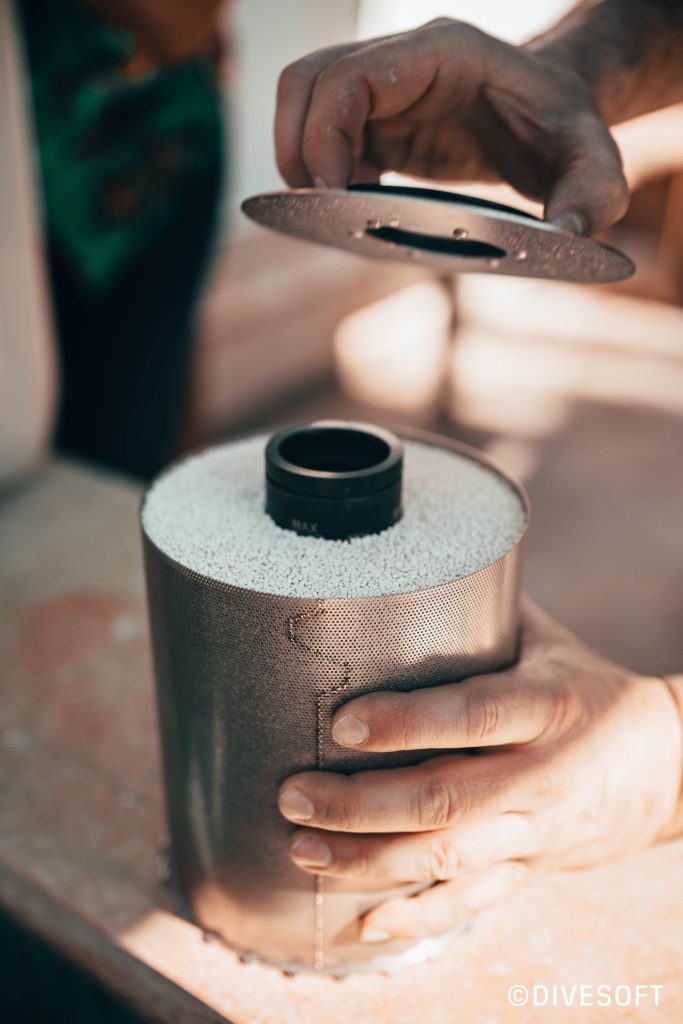
Because of its sensitive and operationally critical applications, soda lime must be stable, inert to a wide range of gases, react predictable, and be cost effective to produce. The long list of requirements and challenging applications make it an interesting case study in chemical innovation, but it comes with some serious tradeoffs.
The chemical makeup of soda lime varies slightly by manufacturer, but it consists of approximately 75% calcium dihydroxide (sometimes called slaked lime), 20% water, 3% sodium hydroxide, and (in the case of many manufacturers) 1% potassium hydroxide.The result is a compound that is relatively inert as a dry powder but that can effectively and reliably react with gaseous carbon dioxide. This then begins a series of chemical reactions resulting in the neutralization of carbon dioxide with water, calcium carbonate, and heat as relevant byproducts. (Freeman, 2014). When used appropriately soda lime is extremely efficient and requires little monitoring, but it poses significant toxic and corrosive hazards if misused. Here’s everything you need to know about your sorb.
Looking Back
Modern soda lime is the result of centuries of attempts to safely recirculate exhaled gas to extend gas supplies and exploration potential. As early as 360 BCE, Aristotle describes divers using upturned pots as “diving bells” to capture their exhaled breath, allowing them to dive deeper and stay longer in order to collect food. There were no scrubbers to speak of at that point, and the effects of carbon dioxide on the divers became a topic of research unto itself.
The first device that really began to resemble the modern rebreather was Giovanni Borelli’s 1680 invention, which used copper tubing cooled by seawater to condense impurities in exhaled gas. Stephen Hale is then credited with one of the first chemical carbon dioxide absorbers, using sea salt and tartar (potassium bitartrate, not the sauce) inside a diving helmet to remove impurities in 1726.
A number of other chemical solutions evolved over the course of time, from barium hydroxide to potassium/sodium hydroxide scrubbers, but the first inklings of modern soda lime can be traced back to 1777. Carl Wilhelm Scheele, a Swedish chemist who is credited with independent discoveries of oxygen, chlorine and manganese, recorded an experiment in which he kept bees alive in a glass jar by absorbing the carbon dioxide they produced with lime water. [For a fascinating history of CO2 absorption see: SODASORB® Manual Of CO2 Absorption]. This experiment was duplicated by Henri Regnault and Jules Reiset in 1847 with dogs, and a granular form of the compound was finally patented in 1930 by Charles A. Carey and the Dewey & Almy Chemical Company, Cambridge, Massachusetts, which was later acquired by chemical giant W.R. Grace in 1954.
Several manufacturers have now developed methods to produce soda lime, and it can be found in a number of similar formulations and granule sizes. While we’re familiar with the technology from its use in diving, soda lime is also used in a number of military and aerospace applications, and sees its widest use in the medical field. Anesthesia machines, some ventilators, and a number of more specialized medical applications all involve breathing circuits similar to those used in rebreathers.
Good Chemistry
As mentioned, soda lime is a granular compound consisting of approximately 75% calcium dihydroxide (Ca(OH)2, 20% water (H2O), 3% sodium hydroxide (NaOH), and 1% potassium hydroxide (KOH) that is designed to neutralize gaseous carbon dioxide in the presence of heat and water (Freeman, 2014). It’s produced in a variety of forms with minor variations. Some products add an indicating agent, most often a purple dye, that illustrates approximately where the reaction front is in the soda lime scrubber and how much unused soda lime remains. Silica is also added to many products to make the granules harder to reduce the formation of alkaline powders which can cause bronchospasm and mechanical complications, and in medical applications additives are included to reduce the potential for reaction with volatile anesthetic gases.

The ability of the powder to absorb carbon dioxide relies specifically on the sodium hydroxide content and can be best understood in a series of three reactions:
(1) CO2 + H2O ⇌ H2CO3
(2) H2CO3 + 2NaOH (or KOH) ⇌ Na2CO3 (or K2CO3) + 2H2O + Heat
(3) Na2CO3 (or K2CO3) + Ca(OH)2 ⇌ CaCO3 + 2NaOH (or KOH)
The first step involves the combination of gaseous carbon dioxide with liquid water and the formation of aqueous H2CO3 or carbonic acid.
(1) CO2 + H2O ⇌ H2CO3
The evolution of the H2CO3 results in a strongly acidic solution with a pH of approximately 3.49, which can be more easily neutralized by the basic sodium hydroxide in the next step of the reaction:
(2) H2CO3 + 2NaOH (or KOH) ⇌ Na2CO3 (or K2CO3) + 2H2O + Heat
In this step, the carbonic acid from the first step is neutralized by either sodium hydroxide or potassium hydroxide, both of which are used as activators to catalyze the formation of sodium and potassium carbonates. These strong bases are ideal for this reaction because they can completely dissociate in water and react with the weak carbonic acid from the first step.
This neutralization reaction results in the evolution of either sodium carbonate and/or potassium carbonate (depending on the original soda lime composition), water and heat. At this point, the gas has entered the soda lime scrubber and passed the reaction front—the area where fresh absorbent meets carbon dioxide in the gas—and is exiting the scrubber. The reaction front will move as soda lime is consumed by the reaction, and the speed and efficiency of the reaction will be affected by factors like temperature, remaining soda lime, heat and humidity, and the concentration of carbon dioxide in the gas.
The final step of the process involves the reaction of calcium hydroxide with the sodium carbonate and potassium carbonate of the products to form calcium carbonate (CaCO3), a stable and insoluble precipitate notably used as a dietary supplement—in toothpaste and in agriculture.
3) Na2CO3 (or K2CO3) + Ca(OH)2 ⇌ CaCO3 + 2NaOH (or KOH)
This step results in the formation of additional hydroxides which are then used to catalyze further reactions with carbonic acid. In this way the hydroxide catalysts are reused, while the calcium dihydroxide is consumed as the scrubber is used. It’s important to note that while the reaction front of the scrubber is typically easy to identify, it is not the only location for carbon dioxide neutralization, which occurs throughout the scrubber. It is just the area in which the greatest level of activity occurs due to the combination of exhaled gas and fresh soda lime.
Absorption Monitoring
Unfortunately, soda lime use has not proven to be without danger. Issues with soda lime in diving and space exploration have primarily fallen into one of two categories; difficulties in monitoring during use, and hazards posed by common mechanical or systemic failures. The first category primarily comes from the difficulty that divers and astronauts have in tracking the reaction time and remaining reaction potential of the soda lime. These users rely on the ability of soda lime to neutralize carbon dioxide in their exhaled gas in inhospitable environments where immediate return to the surface or an atmosphere conducive to life is not always possible.
The resulting hypercapnia, spurred by high end-tidal carbon dioxide, can result in unconsciousness or death in the environments that these divers and astronauts work in, and warning signs may be nonexistent or masked by mental and physical impairments caused by other symptoms of high carbon dioxide levels. The hypercapnia that results from high end-tidal carbon dioxide is one of the most dangerous threats that rebreather divers face, and various methods have been developed to track reaction speed and remaining reaction potential.
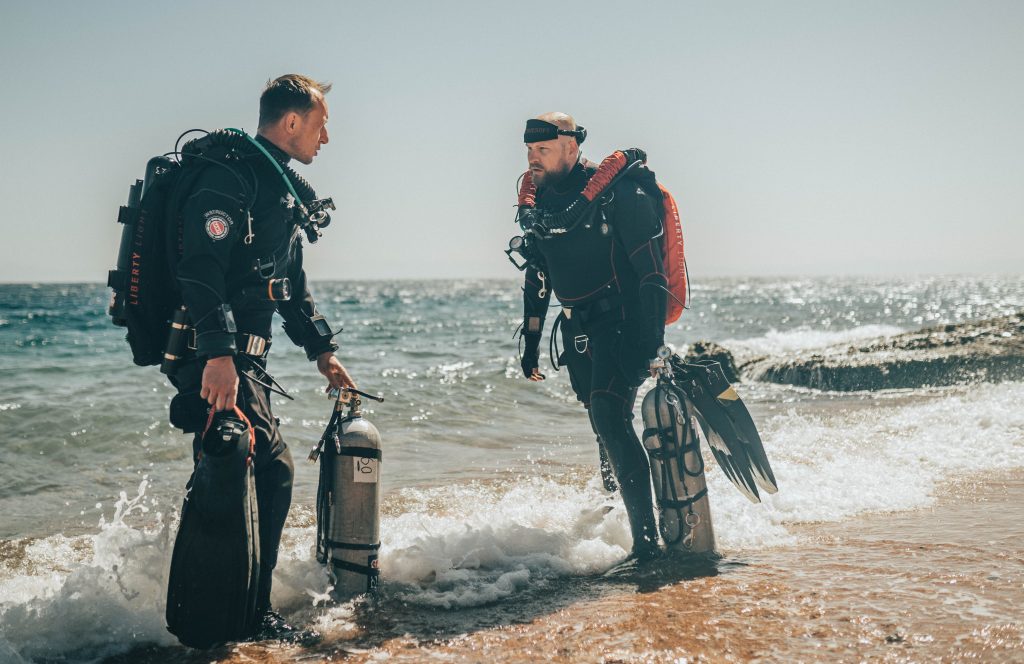
In medical applications, a dye that is activated by the carbon dioxide neutralization reaction indicates the usage of a scrubber, but this has proven unreliable in rebreathers. Because the dye relies partially on temperature, it can revert in the time it takes for a diver to get out of the water and inspect their scrubber, and it has proven to be an unreliable indicator of scrubber usage in the high-gas density and moist environment of a rebreather. Additionally, the U.S. Navy implicated indicating absorbent as a possible cause of an ammonia-like odor reported during a dive in 1992, and its use was discontinued. Follow-up work showed that ammonia, ethyl and diethyl amines, and aliphatic hydrocarbons were found in both Sodasorb and Sofnolime scrubbers, possibly as a result of a breakdown of the indicating dye, but the work was not able to be reproduced in similar environments, leaving some question as to the source of the contamination.
More modern approaches have used temperature probes, also known as temperature sticks, or “temp stiks,” which were developed independently during the last decade by both the U.S.Navy Experimental Diving Unit (NEDU) and AP Diving, as well as diver physiological metrics to estimate scrubber usage. According to a 2019 paper, temp stiks have been shown effective in providing a timely warning of significant CO2 breakthrough. However, the majority of divers still estimate their scrubber duration via fairly crude calculations based on known reaction potentials, with enormous conservatism factors applied to those calculations.
Approximately 100g of soda lime is known to absorb 26L of carbon dioxide (Freeman, 2014), and some variation of this estimation is used by most training agencies and manufacturers as a basis for their scrubber duration. Some manufacturers do complete more involved laboratory tests to confirm scrubber performance under known conditions, such as the Conformité Européene (CE) EN14143 test, which measures scrubber duration at a depth of 40 m/131 ft, water temperature 4ºC/39.2ºF, 40 liter/minute breathing rate, and a CO2 production rate of 1.6 liter per minute. However, the extent of these tests varies by rebreather manufacturer.
The difficulty in estimating scrubber performance, even with a known reaction potential, lies in the huge variability in absorbent performance based on temperature, gas density, how the scrubber was packed, and the design of the scrubber.
Diver physiological metrics can also be used to estimate scrubber usage. For example, Global Underwater Explorers (GUE) has developed a relatively recent approach to safely estimating scrubber duration, called Absorbent Canister Endurance (ACE) using theoretical soda lime absorption performance. These calculations are only as accurate as their premise, so it’s important to understand that the ACE approach relies on all of the same variables as the CE endurance test, except for the metric for carbon dioxide production. This metric is hugely variable between divers, but can be estimated based on RMV and oxygen consumption with a volume of carbon dioxide produced (VCO2) and volume of oxygen consumed (VO2) assumed to be equal.
Caustic Cocktails Anyone?
Because soda lime relies on extremely caustic sodium and potassium hydroxides to catalyze the carbon dioxide neutralization reaction, the combination of the granular powder with more water than required for the reaction can result in significant injuries. This presents additional challenges, because the scrubbers require some moisture to function, but uncontrolled liquid in a scrubber can dissolve some unreacted soda lime and create a caustic slurry. Ingestion or inhalation of this slurry, which has an estimated pH of 14, can cause burns to the mouth, throat and airway, and cause general respiratory distress.
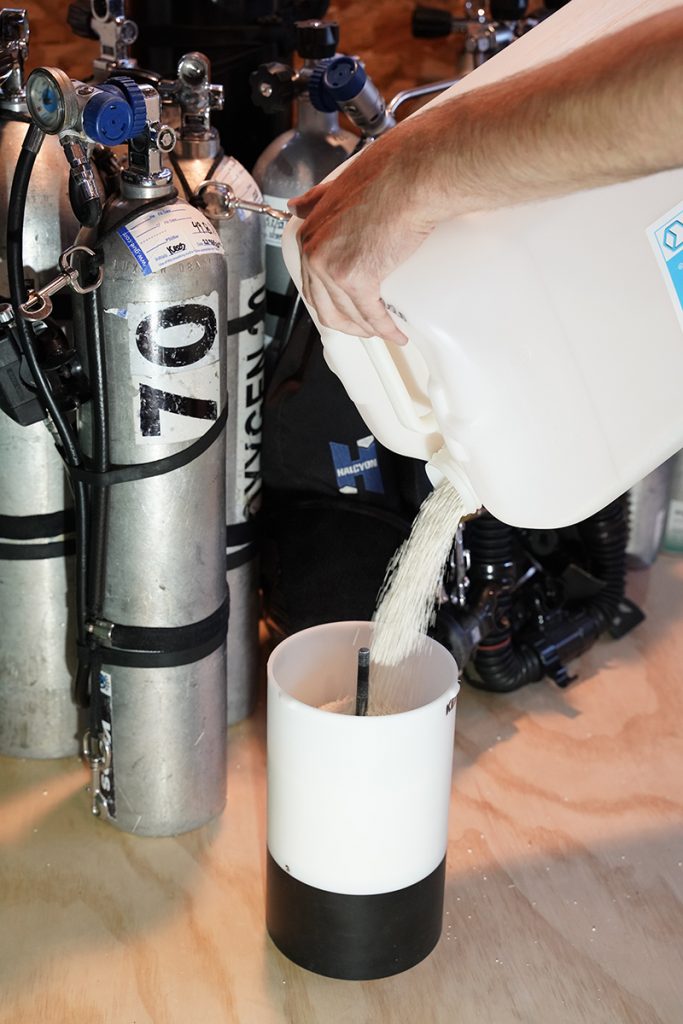
In at least one case documented at the Department of Emergency Medicine at the University of California, San Diego, small amounts of water endered a Drager LAR V closed circuit oxygen rebreather resulting in an aqueous soda lime solution entering the patient’s lungs and causing an overwhelming burning sensation in his oropharynx and chest, resulting in an emergency ascent that could have caused further injuries. The good news is that this type of “caustic cocktail” injury is often caught quickly by divers, and most often results in minor irritation to the mouth and throat. In the event of a cocktail, the diver should bailout and if possible immediately flush out the caustic fluid from the mouth and oral cavities while underwater. If the soda slurry does get into the stomach it’s not a serious problem; the concern is more the pharynx and esophagus. Drinking water at the surface is encouraged. Note that Divers Alert Network (DAN) is currently conducting its Rebreather Survey 2020 to collect information on caustic cocktails.
Interestingly, in medical applications, soda lime poses an additional hazard. The mechanism is yet-undetermined but desiccated soda lime and high flow application of volatile organic gases, like those used for anesthesia, have been implicated in the production of substantial amounts of carbon monoxide. This phenomenon does not occur in soda lime used at the correct humidity, nor does it occur with diving gases, but it illustrates the importance of maintaining soda lime moisture at appropriate levels.
Storing Your Scrubber
It’s easy to fall into the trap of extrapolating safety data into absurdity, and scrubber storage is one area where message board communities run rampant with safety policing. While it’s true that erring on the side of caution is important, particularly for rebreather divers, the data just doesn’t support the idea that a used scrubber should be discarded immediately. As long as soda lime is kept at the moisture content required by the manufacturer (typically 16-20%) and away from light, heat and contamination, it stands to reason that a used scrubber can be stored and reused as long as usage is carefully recorded and duration estimated conservatively.
Researchers at Laval University and the University of Auckland recently put scrubber storage to the test, storing used scrubbers with known carbon dioxide exposures open, sealed in an airtight plastic bag, and open overnight and then sealed in a plastic bag. These scrubbers were stored in this manner for 28 days, then then put back into a laboratory simulation of a working rebreather and tested until failure. While the scrubber stored in room air lasted an additional 188 minutes, the vacuum sealed scrubber lasted 241 minutes and the scrubber left open overnight and then sealed lasted 239 minutes. In no case did the scrubbers fail spectacularly, and while the sample size is relatively small, it appears that storage in a vacuum sealed bag, with or without leaving the scrubber in room air overnight to dry from use, is a safe way to store and then reuse packed soda lime.
References
- Freeman, B. S. & Berger, J. S. (2014) Anesthesiology Core Review: Part One Basic Exam. New York, McGraw-Hill Education Medical.
Dive Deeper
GUE’s ACE Method of Estimating Your Scrubber Duration
How To Pack Your JJCCR Scrubber
From the blog of John Clarke, retired scientifici director of NEDU:
A Look Inside Rebreather Scrubber Canisters, Part 1
How Long Will Your Rebreather Scrubber Canister Last?
In Diving, What is Best is Not Always Good
Shearwater Research: The CO2 Scrubber In A Diver’s Rebreather: How Long Does It Work And How Long Does It Actually Last? by Dan Warkander

Reilly Fogarty is an expert in diving safety, hyperbaric research and risk management. Recent work has included research at the Duke Center for Hyperbaric Medicine and Environmental Physiology, risk management program creation at Divers Alert Network, and emergency simulation training for Harvard Medical School. A USCG licensed captain, he can most often be found running technical charters and teaching rebreather diving in Gloucester, Massachusetts.



















